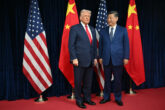June 22, 2018
Toward a New Maritime Strategy in the South China Sea
China’s attempts at unilaterally changing the status quo in maritime Asia are most visible in the South China Sea, where previously small land features are now burgeoning military outposts. The United States needs to retool its approach to China in the Western Pacific and move toward a new maritime strategy.
China’s buildup of armed forces and installations on disputed islands in the South China Sea highlights twin ambitions of solidifying expansive territorial claims and demonstrating Beijing’s growing military reach out to the Second Island Chain and beyond. Landing long-range H-6K bombers on China’s largest outpost in the Paracel archipelago could presage similar moves on the Subi, Mischief, and Fiery Cross Reefs in the Spratly Islands. The fortification of South China Sea installations is both a byproduct of and a means to so-called gray-zone challenges to the existing order. China seeks to change the status quo through incremental actions, mobilizing both military and paramilitary forces, and threats of coercion — but stopping short of steps that might trigger conflict.
The United States is pursuing several lines of effort to counter Chinese aggression, including naming and shaming China’s unilateral assertions, bolstering allied and partner capacity, and conducting more frequent but routine freedom of navigation operations (FONOPs). In response to China’s destabilizing moves in the Spratly and Paracel Islands, the U.S. disinvited the People’s Liberation Army Navy from the 2018 Rim of the Pacific (RIMPAC) Exercise in late July, citing that China’s actions undermine regional security, transparency, and freedom of the seas. Despite this increased effort, there are still key areas lacking in the proposed U.S. maritime strategy.
Read the Full Article at The Diplomat
More from CNAS
-
North Korea Reveals Troop Dispatch to Russia amid U.S.-South Korea Policy Talks
North Korea has confirmed for the first time that its troops are operating in Russia, and it is preparing to rewrite its party charter with the possibility of officially namin...
By Dr. Go Myong-Hyun
-
Chinese Maker of Bitcoin-Mining Machines Is a Security Threat, Says Expert
Bloomberg News reports that a Chinese manufacturer, Bitmain Technologies Ltd, that sells most of the world’s Bitcoin-mining machines — including 16,000 of them to a venture ba...
By David Feith
-
Indo-Pacific Security / Energy, Economics & Security
North Korea’s Provocations, Power Plays, and Shifting AlliancesTensions on the Korean Peninsula have reached a new and dangerous threshold. President Lee Jae Myung is warning of a real risk of accidental military clashes, as the situation...
By Dr. Go Myong-Hyun
-
Indo-Pacific Security / Energy, Economics & Security
How to Win the Economic War with ChinaTrump's approach to China has run aground, giving Beijing unprecedented advantage in the economic conflict....
By Edward Fishman & Julian Gewirtz



